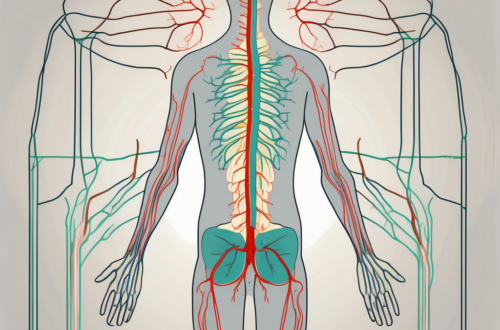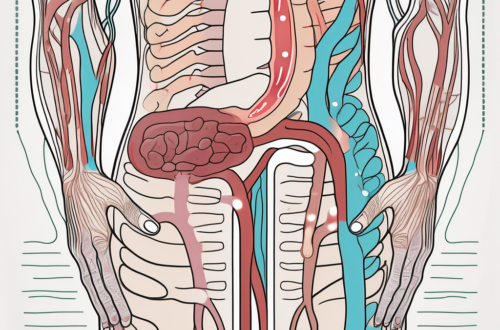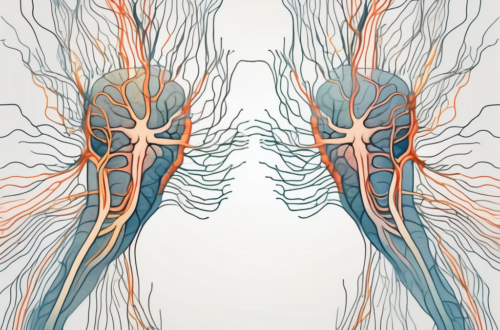The nervous system is an intricate network within our bodies that controls and coordinates various functions. It plays a crucial role in maintaining homeostasis and regulating our responses to external stimuli. Within the nervous system, there are two branches known as the sympathetic nervous system and the parasympathetic nervous system. These two systems work in opposition to each other, but they are both essential for our overall well-being. In this article, we will delve into the differences in nerve length between the sympathetic and parasympathetic systems, examining their functions and implications.
Understanding the Nervous System
Before we dive into the specifics of the sympathetic and parasympathetic nervous systems, it is important to have a solid grasp of the nervous system as a whole. The nervous system, consisting of the central nervous system (CNS) and the peripheral nervous system (PNS), is responsible for transmitting signals throughout the body and coordinating our bodily functions. The CNS, composed of the brain and spinal cord, serves as the control center, while the PNS extends throughout the body, connecting the CNS to various organs and tissues.
Through the intricate network of neurons, the nervous system enables communication between different parts of the body, allowing for efficient functioning and adaptation to external stimuli. This communication occurs through electrical and chemical signals, ensuring proper coordination of bodily processes.
The nervous system is truly remarkable in its complexity and efficiency. It is composed of billions of neurons, each with its own unique structure and function. These neurons work together to transmit information at lightning-fast speeds, allowing us to perceive the world around us, make decisions, and carry out actions.
One fascinating aspect of the nervous system is its ability to adapt and change. This phenomenon, known as neuroplasticity, allows the brain to reorganize itself in response to new experiences or injuries. Neuroplasticity plays a crucial role in learning, memory, and recovery from brain damage.
The Role of the Sympathetic Nervous System
The sympathetic nervous system is often referred to as the “fight or flight” response system. It activates in response to stress, fear, or any situation that requires an immediate response. When activated, the sympathetic system increases heart rate, dilates airways, and redirects blood flow towards vital organs to prepare the body for action.
It is involved in releasing stress hormones such as adrenaline, which heightens our awareness and boosts physical performance. The sympathetic nervous system also plays a role in regulating blood pressure, body temperature, and sweating.
Imagine a scenario where you encounter a dangerous animal in the wild. Your sympathetic nervous system would kick into gear, preparing your body to either fight the animal or flee from it. Your heart rate would increase, supplying more oxygen and nutrients to your muscles. Your airways would dilate, allowing for increased oxygen intake. And your blood would be redirected from non-essential organs, such as the digestive system, to the muscles and other vital organs needed for survival.
The sympathetic nervous system is an essential component of our survival mechanism, enabling us to respond quickly and effectively to potential threats in our environment.
The Function of the Parasympathetic Nervous System
In contrast to the sympathetic nervous system, the parasympathetic nervous system is responsible for the body’s “rest and digest” response. When activated, it promotes relaxation, aids in digestion, and conserves energy. The parasympathetic system slows heart rate, constricts airways, and increases blood flow to the digestive organs.
It is during times of rest and relaxation that the parasympathetic system enables the body to repair and rejuvenate itself. It promotes efficient digestion, reduces stress hormone levels, and enhances the immune response. The parasympathetic nervous system helps to maintain a state of balance and restoration in the body.
Think of a moment when you are lying in a hammock on a warm summer day, feeling completely at ease. Your parasympathetic nervous system is at work, ensuring that your body is in a state of relaxation and restoration. Your heart rate slows down, allowing your body to conserve energy. Your airways constrict, promoting a sense of calm and tranquility. And your digestive organs receive increased blood flow, aiding in the digestion and absorption of nutrients.
The parasympathetic nervous system is crucial for our overall well-being, allowing us to recharge and recover from the demands of everyday life.
The Anatomy of Nerve Length
Defining Nerve Length
Nerve length refers to the physical distance that nerve fibers extend within the body. It is a crucial aspect of the nervous system as it determines the pathway and reach of electrical signals transmitted through these fibers. The length of nerves can vary significantly depending on various factors, including individual variations and specific anatomical structures.
Understanding the intricacies of nerve length is essential in comprehending the complexity of the human body. Nerve fibers, like intricate highways, traverse through the body, connecting various organs, tissues, and cells. These fibers act as messengers, transmitting vital information and coordinating the body’s functions.
It is important to note that nerve length is not a standardized measure and can differ between individuals. Factors such as height, body composition, and genetic variability can influence nerve length. Additionally, certain medical conditions and injuries may also affect nerve length.
Imagine a world where nerve length was uniform across all individuals. The human body would lose its uniqueness, and the diversity of our anatomy would be diminished. The intricate dance of nerve fibers, adapting and adjusting to each person’s physicality, is what makes us truly remarkable.
Factors Influencing Nerve Length
Several factors can influence the length of nerves within the sympathetic and parasympathetic systems. One significant factor is the anatomical location of the nerves. The sympathetic nerves emerge from the thoracic and lumbar regions of the spinal cord, while the parasympathetic nerves primarily originate from the cranial and sacral regions.
As nerve fibers navigate through the body, they encounter a myriad of obstacles and pathways. The intricate web of bones, muscles, and organs creates a unique environment that influences the length of nerves. It is fascinating to think about how the body adapts to these challenges, ensuring that nerve fibers reach their intended destinations.
Furthermore, the density and branching patterns of nerve fibers can also contribute to variations in nerve length. Individuals with a higher number of nerve fibers or more complex branching patterns may have longer nerves within their sympathetic or parasympathetic systems.
Imagine a microscopic view of nerve fibers, resembling a dense forest with countless branches intertwining and connecting. The complexity of these branching patterns is a testament to the intricacy of the human body. Each branch represents a connection, a pathway for electrical signals to travel, ensuring the seamless functioning of our bodily systems.
It is worth noting that while some variation in nerve length exists, the overall structure and distribution of the sympathetic and parasympathetic systems remain generally consistent across individuals. This consistency allows medical professionals to understand and diagnose certain conditions, relying on the predictable patterns of nerve length and distribution.
Delving into the depths of nerve length reveals a world of wonder and complexity. The human body’s ability to adapt and adjust, ensuring the optimal functioning of our nervous system, is a testament to the marvels of nature. The study of nerve length continues to unravel the mysteries of our anatomy, shedding light on the intricate connections that make us who we are.
Comparative Analysis of Sympathetic and Parasympathetic Nerve Length
Methodology of Comparison
To analyze the differences in nerve length between the sympathetic and parasympathetic systems, researchers have employed various methods. These include dissection studies, imaging techniques such as magnetic resonance imaging (MRI), and autonomic nervous system mapping.
Dissection studies involve carefully dissecting cadavers or animal specimens to examine the anatomical structures of the sympathetic and parasympathetic nerves. This method allows researchers to directly measure the length of the nerves and observe their distribution throughout the body.
Imaging techniques, such as MRI, provide a non-invasive way to visualize the sympathetic and parasympathetic nerves in living subjects. By capturing detailed images of the nervous system, researchers can estimate the length of the nerves and compare them between the two systems.
Autonomic nervous system mapping involves using specialized techniques to trace the pathways of the sympathetic and parasympathetic nerves. This method allows researchers to create comprehensive maps of the nerve networks and determine their lengths.
Through these approaches, researchers have been able to identify the general patterns of nerve length within each system and compare them in terms of absolute measurements and relative ratios.
Key Findings from the Analysis
Studies investigating sympathetic and parasympathetic nerve length have revealed interesting insights into the anatomical differences between these two systems. While the sympathetic system tends to consist of longer nerves that extend throughout the body, the parasympathetic system tends to have shorter, more localized nerves.
For example, in the sympathetic system, the nerves originating from the thoracic and lumbar regions of the spinal cord can extend all the way to the extremities, providing innervation to organs, muscles, and blood vessels throughout the body. In contrast, the parasympathetic system primarily consists of cranial and sacral nerves that have shorter pathways and target specific organ systems, such as the heart, lungs, and digestive tract.
This difference in nerve length is believed to be associated with the specific functions of each system. The sympathetic nervous system covers a wider range of physiological responses, necessitating greater nerve length to reach various organs and tissues. This allows for rapid and coordinated responses in situations such as fight-or-flight responses. On the other hand, the parasympathetic system primarily targets specific organ systems, requiring less extensive nerve length. This allows for more precise control over bodily functions, such as digestion and rest-and-digest responses.
These findings have important implications for understanding how the sympathetic and parasympathetic systems regulate different bodily processes and respond to various stimuli. By having longer nerves, the sympathetic system can quickly transmit signals to multiple organs simultaneously, enabling a coordinated response to stressors. In contrast, the parasympathetic system’s shorter nerves allow for more localized control, ensuring that specific organs receive the appropriate signals for their functions.
However, it is crucial to recognize that these findings provide a general framework and that individual variability exists within these systems. While the overall patterns of nerve length may hold true for most individuals, there can be variations in specific cases. Factors such as genetics, age, and overall health can influence the length and distribution of sympathetic and parasympathetic nerves in different individuals.
Implications of Nerve Length Differences
The variations in nerve length between the sympathetic and parasympathetic systems have significant implications for physiological functions. The sympathetic system’s extensive nerve length allows for rapid transmission of signals to various organs and tissues, facilitating quick responses during stressful situations.
For example, when faced with a sudden threat, such as encountering a predator, the sympathetic nervous system activates the “fight or flight” response. This response triggers a cascade of physiological changes, including increased heart rate, dilation of blood vessels, and heightened alertness. The long nerve length of the sympathetic system enables the rapid transmission of these signals, ensuring a swift and coordinated response throughout the body.
On the other hand, the localization of parasympathetic nerves allows for focused regulation of specific organ systems. This precision contributes to efficient digestion, restful states, and optimal functioning of various bodily processes.
When we are in a relaxed state, such as during sleep or after a satisfying meal, the parasympathetic system takes over, promoting rest and restoration. The shorter nerve length of the parasympathetic system allows for targeted control over specific organs, such as the digestive system. This precision ensures that the body can efficiently break down food, absorb nutrients, and eliminate waste.
Potential Health Implications
Understanding the differences in nerve length between the sympathetic and parasympathetic systems can provide insights into potential health implications. Variations in nerve length may contribute to differences in individual responses to stress, susceptibility to certain diseases, and overall physiological balance.
For instance, individuals with longer sympathetic nerves may be more prone to experiencing heightened stress responses. This could manifest as increased heart rate, elevated blood pressure, and a heightened sense of anxiety in stressful situations. On the other hand, individuals with shorter parasympathetic nerves may be more susceptible to digestive disorders, as the precise regulation of the digestive system may be compromised.
However, it is important to note that nerve length alone is not a determining factor for health outcomes. Various other factors, such as overall nervous system health, lifestyle choices, and genetic predispositions, also play critical roles.
For example, individuals with a healthy lifestyle, which includes regular exercise, a balanced diet, and stress management techniques, can mitigate the potential negative effects of nerve length differences. Additionally, genetic factors can influence an individual’s susceptibility to certain diseases, regardless of nerve length.
If you have concerns about your nervous system function or any related symptoms, it is always advisable to consult with a healthcare professional who can provide accurate assessments and guidance tailored to your individual circumstances.
Future Research Directions
The study of nerve length in the sympathetic and parasympathetic systems has yielded significant progress in recent years. However, there are still several unanswered questions that require further investigation. Researchers are eager to explore the underlying cellular and molecular mechanisms that contribute to the observed differences in nerve length between these two systems.
Moreover, understanding the impact of abnormal nerve length on overall health and disease progression is an important area of exploration. By studying the interconnectedness between nerve length and physiological outcomes, researchers hope to gain valuable insights into the potential implications for various health conditions.
Potential Areas of Exploration
Future research endeavors may focus on investigating the influence of lifestyle factors on nerve length and overall nervous system function. For instance, studies could delve into the effects of exercise and stress management on nerve length. By understanding how these lifestyle factors impact nerve length, researchers can shed light on ways to optimize nerve length and enhance overall well-being.
Another intriguing avenue for investigation is the potential for interventions to optimize nerve length. Researchers may explore targeted therapies or neuromodulation techniques to promote nerve lengthening or prevent abnormal nerve length. Such interventions could potentially have far-reaching implications for improving physiological health and well-being.
By delving deeper into these areas, researchers can expand our knowledge of the sympathetic and parasympathetic nervous systems and their relationship to nerve length. This expanded understanding may pave the way for new therapeutic approaches and promote better understanding of the interplay between nerve length and physiological health.
Furthermore, it would be interesting to investigate the long-term effects of nerve length on various health outcomes. For example, researchers could explore the relationship between nerve length and the risk of developing chronic diseases such as cardiovascular disease, diabetes, or neurodegenerative disorders. Understanding these associations could provide valuable insights into the potential preventive and therapeutic strategies.
Additionally, researchers could investigate the role of genetics in determining nerve length. By studying the genetic factors that influence nerve length, scientists can gain a deeper understanding of the underlying mechanisms and potentially identify genetic markers associated with abnormal nerve length.
Moreover, exploring the impact of nerve length on cognitive function and mental health is an area that warrants further investigation. Understanding how nerve length influences brain function and mental well-being could have significant implications for the development of targeted interventions for neurological and psychiatric disorders.
Lastly, researchers could explore the potential role of nerve length in the aging process. Investigating how nerve length changes with age and its impact on age-related health outcomes could provide valuable insights into the biology of aging and potentially lead to interventions that promote healthy aging.
Conclusion
The comparative analysis of sympathetic and parasympathetic nerve length offers valuable insights into the functioning of the nervous system. Understanding the differences in nerve length provides a framework for comprehending their respective roles in regulating physiological processes and responses to external stimuli.
While nerve length is just one aspect of the complex interplay within the sympathetic and parasympathetic systems, it contributes to the overall efficiency and functioning of the nervous system. Further research, along with advancements in technology and methodologies, will continue to expand our understanding of nerve length and its connection to health and well-being.
Remember, if you have any concerns about your nervous system or overall health, it is always recommended to consult with a healthcare professional who can provide personalized advice and guidance based on your individual needs.





